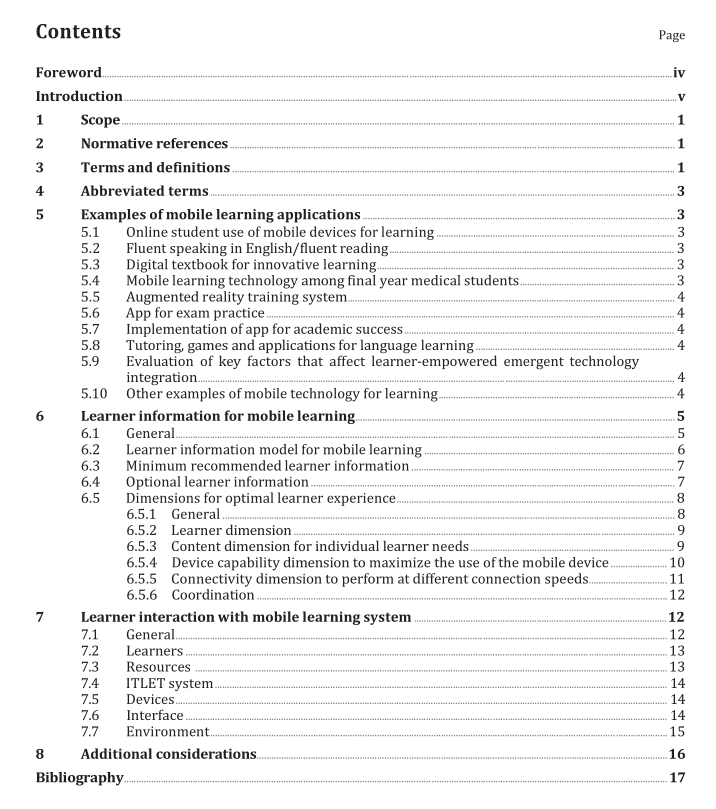ISO IEC 29140 pdf – Information technology for learning, education and training — Nomadicity and mobile technologies

ISO IEC 29140 pdf – Information technology for learning, education and training — Nomadicity and mobile technologies
5.5 Augmented reality training system An augmented reality training program was developed by an augmented reality organization to train industrial sales and service workers on how to dismantle and re-assemble an accentuator valve. The trainee used tablets or augmented reality glasses, or both, with positioning markers to overlay holographic, step-by step instructional images on a real-world accentuator valve to dismantle and re-assemble the valve. The project was evaluated using a pragmatic mixed-methods approach. See Reference [16]. 5.6 App for exam practice Malezi exam practice is a mobile friendly web application that generates examination revision content for learning and testing readiness for final level exams in both primary and secondary school. See Reference [17 ].
5.7 Implementation of app for academic success The University of Waterloo, Ontario, developed a tri-lingual (English, French, Chinese) mobile learning application designed to facilitate anywhere and at any time academic integrity training. The project is designed to improve student engagement with academic material by exploring mobile learning to better resonate with the university/college student population. The app has the capacity to provide an e-certificate and digital badge upon successful completion of the module lessons. See Reference [18].
5.8 Tutoring, games and applications for language learning The purpose of the FirstVoices mobile applications for language learning (MALL) is to preserve and to promote First Nations languages. Over 60 Aboriginal languages are archived, some only available to members of that community. The resources are used by First Nations communities in Canada to teach, learn and document their words, phrases, songs, stories and other digital community resources. FirstVoices also serves as central language data platform for other applications. See Reference [19].
5.9 Evaluation of key factors that affect learner-empowered emergent technology integration Wark ’s dissertation sought to determine what key institutional, curricular, instructional and contextual factors and, ultimately, what educational paradigm most enabled online graduate level learners to integrate emergent technologies for learning on demand. See Reference [20]. 5.10 Other examples of mobile technology for learning As the use of mobile technologies grows around the world, the infrastructure to support mobile learning is being improved to allow access anywhere and at any time to learning applications, services and content. In several countries, corporate, academic and government organizations are using existing learning management systems to implement and provide support for mobile learning. In some countries, connectivity is sufficient to allow learners to access learning resources and participate in teaching and learning activities through connecting to networks using mobile devices. There is a shift from wired to wireless connection that will facilitate the use of mobile technology in learning. Mobile learning is being used to improve access to learning materials and services that will facilitate individual learning, education and training from anywhere and at any time. Additional examples of mobile learning applications include the following:
— Educational organizations are making their digital learning materials available as open access so that the materials can be re-used at no cost providing the materials are used for education. In most cases, the materials can be accessed using mobile technologies.
— Use of artificial intelligence (AI) to adapt learning to meet individual learner needs.
— Organizations are developing and delivering massive open online courses (MOOCs), which are free for anyone to participate. In some cases, learners can complete the MOOCs using mobile technologies.
— Countries and organizations are using mobile technologies to educate refugees who live in camps and cannot go to school, so that they can get the knowledge and skills to be integrated into society.
— In large geographically dispersed countries, mobile technologies are used to facilitate the delivery of information and learning materials to learners in any geographic location. Universities are developing digital repositories that have courses that link to learning resources, allowing learners to access course materials from anywhere and at any time using a variety of technologies, including mobile technology.









